| WAT MAHEYONG (วัดมเหยงคณ์) |
| Wat Maheyong is located outside the city island in Hantra sub-district of Ayutthaya, which is part of the ancient area of Ayodhya, inhabited before the establishment of Ayutthaya in 1351. This ancient Ayodhya community was situated on the stretch of land formed by Khlong Hantra, Khlong Ban Bat / Kramang and the Pa Sak River. Following the Luang Prasoet chronicles the monastery was built in 1438 A.D. at the start of the reign of King Borommaracha II (r. 1424-1448) of the Suphannaphum Dynasty (also called Chao Sam Phraya or King Thai Sa). Later Royal chronicles of Ayutthaya (written after the fall of Ayutthaya) changes that date and put the temple's construction in 1424 A.D., a year generally accepted as being King Borommaracha's throne ascendancy. The Royal Chronicles of Ayutthaya mention that Chao Phraya Maha Sena had his stockade set up in the Hantra plains during the war with Burma in 1563-1564. His stockade was attacked by the Burmese troops of the Maha Uparat, but he was able to withstand the first attack. The second attack although, he had to give terrain and was driven with his men into the Hantra Canal (where many wounded drowned) and crossed over to the Maheyong Monastery. "The King of Hongsawadi commanded that the Maha Uparacha be ordered to [E: approach and] take the stockades on the Hantra Plain so that [BF: plans could be made for approaching Ayutthaya] [CDE: the registration system of Ayutthaya could be studied]. At dawn on the next day, Tuesday, the third day of the waning moon in the fourth month, the Maha Uparacha took his soldiers to attack the stockade of Caophraya Maha Sena. Caophraya Maha Sena and his officers fought capably and the enemy was unable to take it by storm. The Maha Uparacha was displeased. [BDEF: Turning] [C: Halting] his elephant [BDEF: to stand] directly in front of, and about three sen from, the stockade, he had it announced to his officers that, "If you do not take the stockade at this time, I will cut off your heads and have them impaled." The officers were afraid and, driving the massed soldiers carrying swords and shields in to reinforce the attack, they were able to take the stockade by storm. Caophraya Maha Sena, his officers and his men fled into the canal and crossed over to the Maheyong Monastery side. Those of the wounded who drowned in the water were numerous. The Maha Uparacha returned with the army to his stockade. Then he went to an audience with the King of Hongsawadi and made his report on all the particulars involved in the conquest of the stockade." [1] During the Burmese war in 1568-1569, the main army of King Bayinnaung encamped at the Maheyong Monastery. He set up his pavilion at the temple and it was here that King Mahin of Ayutthaya (King Mahinthrathirat) (r. 1568-1569) presented himself to the Burmese King after the fall of the capital on 30 August 1569. King Mahin and the royal family were taken captive to Pegu. Maha Thammaracha of Phitsanulok, who joined forces with Bayinnaung against Ayutthaya, was set up as King. King Mahin died of fever on the way to Burma. "As soon as his army and naval forces were all assembled, the King of Hongsawadi issued orders for all his forces to lay siege to the Capital: The army of the Uparat and the army of Prince Thammaracha to the front ramparts in the east, the army of the King of Ava to [F: encamp to] the south, the armies of the Phraya of Thala, of the Thai Yai princes and of the Chiang Mai phraya, sæn and luang to [F: encamp to] the west, and the armies of the Phraya of Bassein, of the Phraya of Tòngu, of Phraya Aphaikhamani, of the Phraya of Lao, [F: the ruler of Martaban,] Phraya Phataba and [D: Phraya] Phataboet to encamp to the north. The main army itself moved [BDF: in] to encamp at Maheyong Monastery." [2] "At that moment the Uparat and Prince Thammaracha proceeded in and halted their royal elephants in front of the Royal Palace. So King Mahin, Lord of the Realm, [B: seeing that Ayutthaya had fallen to the King of Hongsawadi,] proceeded forth with his royal palanquin to Prince Thammaracha [B: in front of the Royal Palace]. So the Uparat [B: and Prince Thammaracha escorted] [CDEF: had] King Mahin, Lord of the Realm, [CDEF: escorted] out to be presented to the King of Hongsawadi at his pavilion at Maheyong Monastery." [3] Wat Maheyong underwent major restoration in the reign of King Thai Sa (r.1709-1732). The restoration started in 1709 and it took more than three years to complete it. The King had a royal residence built, south of the temple in order to follow its restoration, and administered royal affairs from that place. After the temple's restoration in 1713, it was dedicated and celebrated with a week-long festival. Wat Maheyong, restored and enlarged, became one of the most significant monasteries before the fall of Ayutthaya. Wat Maheyong consists basically of a large, eastern-orientated ubosot or ordination hall, a main chedi, a number of satellite chedi and an enclosure. The large ordination hall is a rectangle-shaped building, 17 m wide and 35 m long. There is a passageway at the east gate, leading to its entry. The ordination hall is surrounded by an inner boundary wall, 38 m wide and 72 m long, topped with small chedis at each of the corners. The ubosot covers half the ground enclosed by the inner boundary wall. There are three doors and an extended portico in the main front and the wall behind the Buddha pedestal is broken up by two doors and an extended portico at the back. The central entrance doorway is larger than the others. Two rows of columns are employed to support the roof and divide off two aisles. The walls are very thick, with deep door and window embrasures. Walls and columns taper towards the top, a characteristic feature of Thai architecture. There are in total six windows, three on each side. Inside are two large pedestals and fragmented sandstone Buddha images. As custom in earlier times, Buddha images were first made from sandstone, coated with stucco, lacquered and finished with gold leaf (see as an example, the multiple Buddha images at Wat Chai Watthanaram). The hall was renovated in the Late Ayutthaya period as can be seen at the foundations which slightly curve in the middle of its length (junk-style), typical for that period. The ubosot is marked off by double sema boundary stones (leaf-shaped flat thick stone plates, usually made of slate, demarcating the sacred area at the eight cardinal points), an indication for Royal temples, although likely belonging to the Ratanakosin period. On the west side of the ordination hall stands the principal chedi. The original chedi broke down, and part of its many-tiered umbrella roof (chattra) or spire can still be seen on the ground. The bell-shaped reliquary tower rests on a square base with sides of 32 m. The base is decorated with eighty elephant (Buddha Siddharta Gautama entered the parinirvana at the age of eighty) figures about one meter high; twenty on each side, ten left and right of every staircase. The elephants' trunks have now mostly disappeared, and their bodies have been heavily restored. Its convex, dome-shaped bell, the square harmika atop the dome and the form of the chattra (the honorific umbrella) above the harmika are all evidence of the Sinhalese style. The design is reminiscent of Chedi Chang Lom in Sukhothai, which has similar elephant decorations, reflecting the Sinhalese tradition of Buddhist architecture. At the inter cardinal directions around the principal chedi are four bell-shaped subordinate chedis. Between the corridor and the north and south outer walls are an octagonal and bell-shaped chedi as well as a vihara. The quadrangular outer wall measures 95 meter on 214 metres and has four large, roofed gate entrances in Late Ayutthaya style. To the west, outside the enclosure, are three other Singalese-styled chedis. To the south stands Tamnak Maheyong or the Royal Residence of Maheyong built by King Tai Sa (Phumintharacha) in order to follow the renovation of Wat Maheyong from close by. The denomination of Wat Maheyong is a Siamese derivative of Mahiyanga. [4] Mahiyanga(naya) was an ancient site in present Uva Province of Sri Lanka, situated 42 Km east of Kandy on the banks of the Mahaweli Ganga river. It was in Mahiyanga that the Buddha Siddhartha Gauthama hovered in the air on his first visit to Lanka in the ninth month after his Enlightenment, in order to frighten the Yakshas. Maha Sumana built there a shrine seven cubits in diameter, all of sapphire, and containing the hair given to him by the Buddha. After the Buddha's death, Sarabhu, a disciple of Sariputta, brought there the collar bone of the Buddha, which he deposited in the stupa, increasing the height of the stupa to twelve cubits. The stupa, following the legend the first stupa of lanka, was raised many times thereafter. The stupa is still in existence. [5] The restored ruin of Wat Maheyong is located in Geo Coord: 14° 21' 49.44" N, 100° 35' 41.99" E. References: [1] The Royal Chronicles of Ayutthaya - Richard D. Cushman (2006) - page 36 / Source: Phan Canthanumat, British Museum, Reverend Phonnarat, Phra Cakkraphatdiphong & Royal Autograph - Prince Maha Thammaracha of Phitsanulok. [2] Ibid - page 61. [3] Ibid - page 73-4. [4] The Kingdom of Siam - A. Cecil Carter (1904) - Page 219. [5] http://www.vipassana.info/ma/mahiyangana.htm - data retrieved 14 February 2012. Consulted works 1. Discovering Ayutthaya - Charnvit Kasetsiri & Michael Wright (2007) - pages 104, 105. 2. Ayutthaya, a world heritage (2000) - pages 108, 109. 3. http://www.art-and-archaeology.com/seasia/ayutthaya |

| "In 800 [Chulasakarat], a year of the horse, when King Boromracha II had built the Maheyong Monastery he ascended the royal throne." |
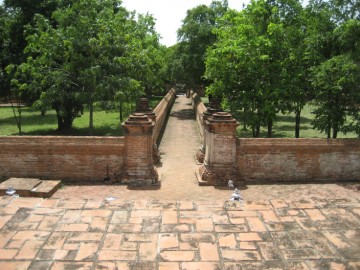
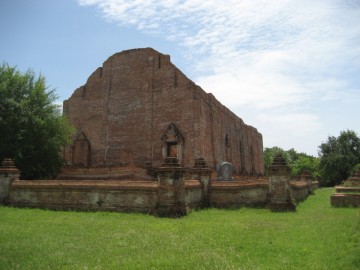



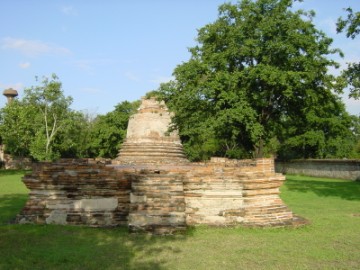
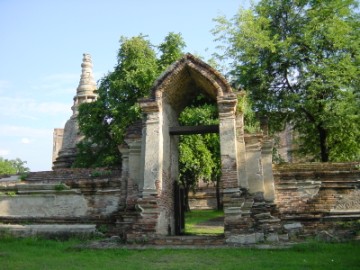
| Text & photographs by Tricky Vandenberg - February 2009 Updated February 2012, January 2015 |
| (Eastern walkway towards the monastery) |
| (Ordination hall viewed from the west) |
| (Ordination hall - view from the inside) |
| (Principal Chedi) |
| (Satellite vihara in situ) |
| (Access portal to the monastery) |
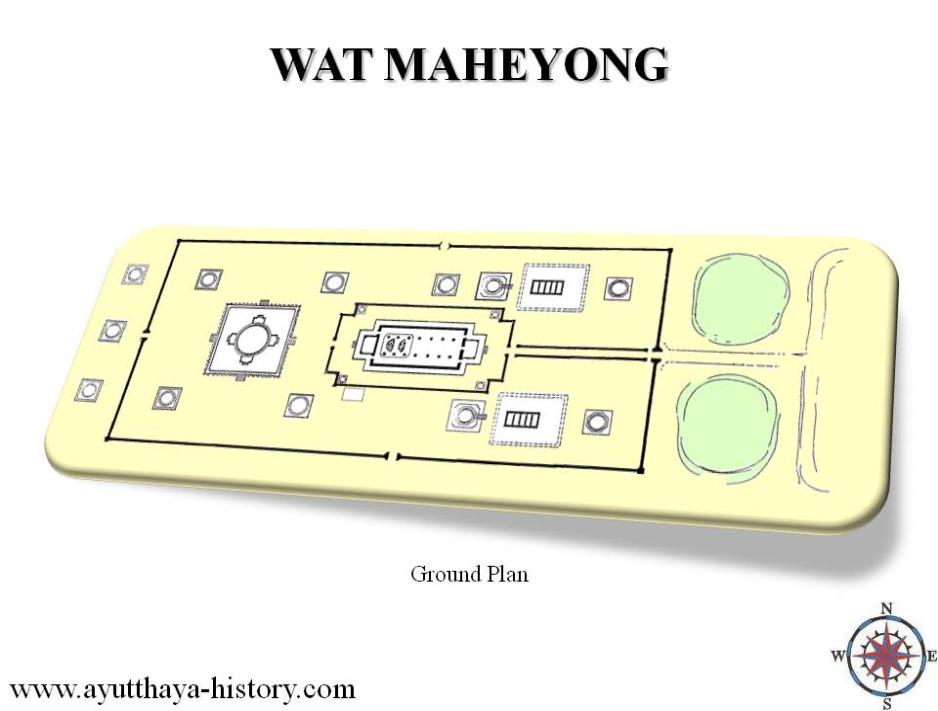
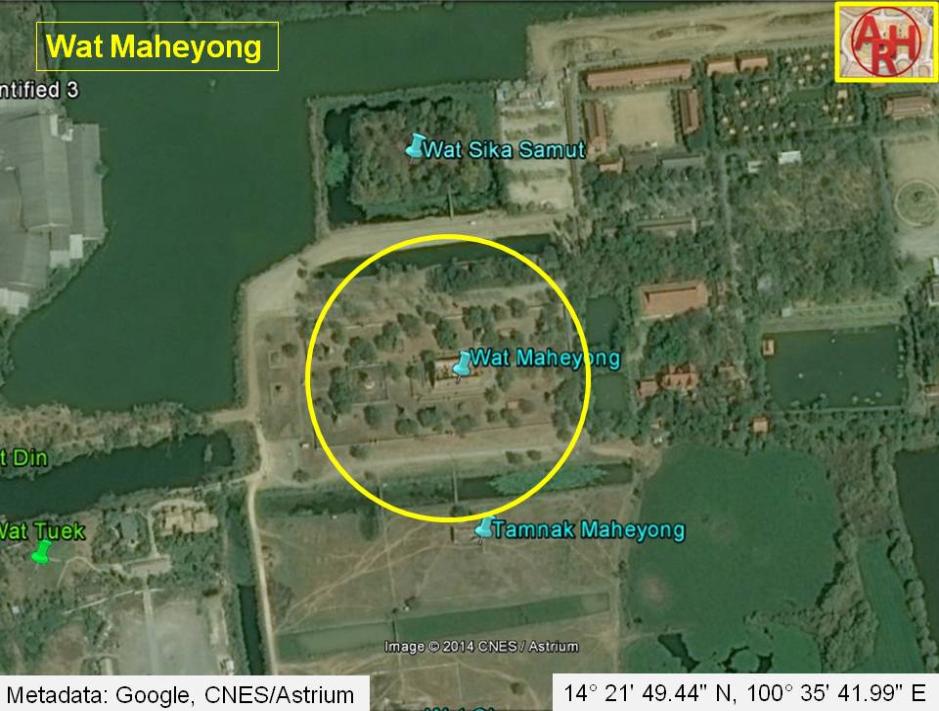

| (Detail of a 2007 Fine Arts Department GIS map - Courtesy of the Fine Arts Department - 3th Region) |
| (Elephant statues surrounding the chedi) |